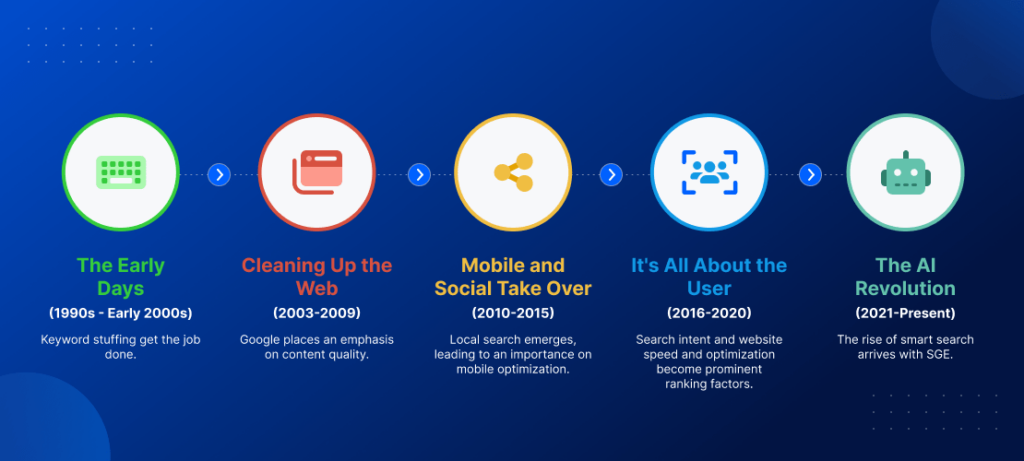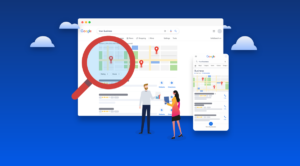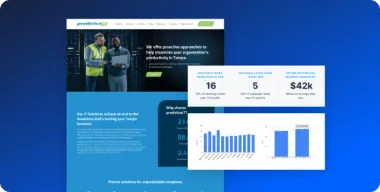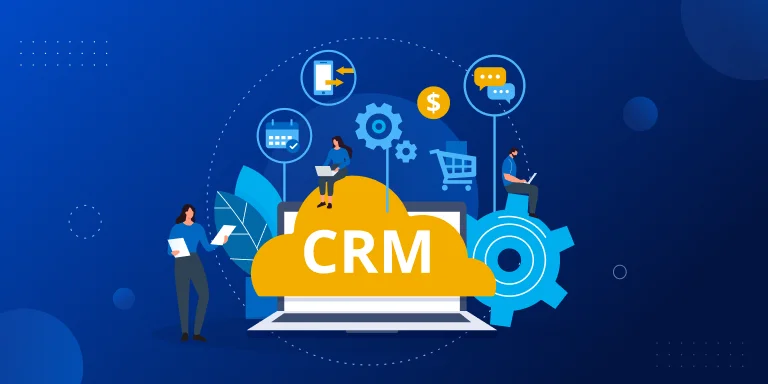ANSWER: SEO isn’t dead — it’s evolving and more crucial than ever for businesses.
Despite the recent AI wave, traditional search engines still dominate online queries. Recent data shows that over 90% of internet searches happen on platforms like Google. And while there’s been a slight dip in website clicks, a substantial 41.5% of Google searches still lead users can click through to websites. That’s a lot of potential traffic for your business.
“Is SEO dead?”
I’m sure you’ve heard it. The whispers about the demise of SEO. As a small business owner, you’ve likely encountered numerous claims that generative search is going to squash the ranking game and change the way we think of SEO altogether. But I want to set the record straight and examine the reality of SEO in 2024. Is it truly dead, or has it just merely transformed?
The truth is, SEO is very much alive, but it’s undergone some major changes. For small businesses, understanding these shifts is pivotal for maintaining and improving your online visibility. So let’s zoom into the current state of SEO, addressing the impact of generative search and highlighting the enduring importance of local SEO strategies.
SEO Through the Years: A Timeline
To grasp where SEO stands today, it’s helpful to understand its historical journey:

The Early Days (1990s – Early 2000s)
In the beginning, the internet was like the Wild West. The first website appeared in 1991, and by 1998, Google arrived on the scene. Back then, SEO was pretty basic — stuff your page with keywords, and you were good to go.
More Details
- 1991: The first website is published
- 1994: WebCrawler, the first full-text search engine, is launched
1997: Google.com is registered as a domain - 1998: Google search engine launches and introduces PageRank, revolutionizing search rankings
- Early 2000s: Keyword stuffing and excessive link building are common tactics
Cleaning Up the Web (2003-2009)
Google started getting smarter. In 2003, they cracked down on keyword stuffing. By 2005, they introduced ways to fight comment spam. The message was clear: quality matters.
More Details
- 2003: Florida Update targets keyword stuffing and commercial manipulation
- 2005: Nofollow attribute is introduced to combat comment spam
- 2008: Google Suggest (now Google Autocomplete) is launched
- 2009: Real-time search is introduced, incorporating social media updates
Mobile and Social Take Over (2010-2015)
Remember when smartphones became a big deal? Google noticed too. They started focusing on local search in 2010 and made sure websites worked well on mobile by 2015. During this time, they also got tough on low-quality content and sneaky link-building tricks.
More Details
- 2010: Google Places and local search become prominent
- 2011: Panda Update targets low-quality content
- 2012: Penguin Update penalizes manipulative link building
- 2013: Hummingbird Update improves semantic search understanding
- 2015: Mobile-friendly update (Mobilegeddon) prioritizes mobile-optimized sites
It’s All About the User (2016-2020)
Google got really good at understanding what people actually want when they search. They started using artificial intelligence (2016) and got even better at understanding natural language (2019). By 2020, they were even looking at how fast and user-friendly your website is.
More Details
- 2016: RankBrain, Google’s machine learning algorithm, is fully rolled out
- 2018: Mobile-first indexing begins
- 2019: BERT Update enhances natural language processing
- 2020-2021: Page Experience Update incorporates Core Web Vitals as ranking factors
The AI Revolution (2021-Present)
We’re now in the age of super-smart search. Google can understand complex queries across different languages (2021) and is experimenting with AI-generated search results (2023). The future of SEO? It’s all about creating helpful, high-quality content that truly serves your audience.
More Details
- 2021: MUM (Multitask Unified Model) is introduced, understanding context across languages and formats
- 2022: Helpful Content Update prioritizes people-first content
- 2023: Google SGE (Search Generative Experience) begins testing
- 2024: AI-powered search features become more prominent, reshaping SEO strategies
The Impact of Generative Search on SEO
So, where does all that leave us today? Well, generative AI, exemplified by Google’s Search Generative Experience (SGE), is indeed changing the search landscape, particularly for broad and top-of-funnel searches.
Here’s how it’s affecting SEO:
- Direct Answers: For many informational queries, AI can generate direct answers, potentially wiping out clicks to websites.
- Enhanced Featured Snippets: AI-generated snippets may provide more detailed information, again potentially reducing the need for users to click through to websites.
- Shift in Content Strategy: Focus on creating targeted content that addresses your audience’s specific needs. Tap into your unique industry expertise and local knowledge to produce content that stands out — even in the age of AI. It’s better to have a few stellar pieces that truly resonate with your audience than a flood of generic content.
- Long-Tail Keyword Importance: As AI handles broad queries, optimizing for specific, long-tail keywords becomes even more important.
- User Intent Focus: Understanding and aligning with user intent is also more important than ever, as AI aims to deliver the most relevant results.
But, it’s crucial to note that generative search is not replacing traditional SEO. Instead, it’s adding a new layer to consider in your strategy.
The Enduring Power of Local SEO
Local search remains largely unaffected by these changes… for now at least.
For small businesses with a physical presence or serving specific geographic areas, local SEO continues to be a powerful tool. Here’s why:
- Maps and Local Pack: Google’s local pack and map results still rely heavily on traditional SEO factors and are not currently impacted by generative AI.
- Google My Business Optimization: Your Google My Business Profile remains a major factor in local search visibility.
- Local Citations: Consistent NAP (Name, Address, Phone) information across the web continues to boost local SEO.
- Local Link Building: Acquiring links from local businesses and organizations still significantly impacts local search rankings.
- Reviews and Reputation: Customer reviews on Google and other platforms remain crucial for local SEO success.
- Localized Content: Creating content that addresses local issues, events, or trends can boost your visibility in local search results.
SEO in 2024: Alive and Well for Small Businesses
So despite what you might hear in podcasts or see on YouTube, SEO is far from dead. It has, however, become more nuanced and integrated with other digital marketing disciplines. So here’s what you need to know:
E-E-A-T (Experience, Expertise, Authoritativeness, Trustworthiness) and User-Focused Content Reigns Supreme
Google still places high importance on E-E-A-T, which aligns closely with creating helpful, reliable, people-first content. For small businesses, this means:
- Demonstrating your expertise through case studies and thought leadership content.
- Understanding and aligning with user intent to provide the most relevant information.
- Creating high-quality, well-formatted content that genuinely answers customer questions.
- Addressing your clients’ specific pain points and showcasing your solutions.
When creating content, ask yourself…
- Does this content demonstrate first-hand expertise and a depth of knowledge?
- Is it addressing the reader’s intended goal for their search query?
- Does it offer unique insights or information not readily available elsewhere?
- Is the content presented in a clear, easy-to-understand format?
Technical SEO Still Matters
While content is king, technical SEO still carries a lot of weight. Site speed, mobile-friendliness, and secure connections (HTTPS) are major ranking factors. Websites, which are increasingly featuring complex information and resources, need smooth navigation and fast load times. It’s huge for both SEO and user experience.
AI and SEO Will Coexist
Rather than killing SEO, AI is enhancing it. AI-powered tools can help with keyword research, content optimization, and predictive analytics. If you own a small business, you can leverage these tools to gain insights into industry trends and competitor strategies. A perfect way to refine your SEO approach for maximum impact.
Conclusion: Embrace the Future of SEO
So, is SEO dead? No, it’s very much alive and remains a major component of digital marketing strategy for small businesses. But, it requires a more nuanced, holistic approach than in the past. You must stay informed about the latest trends, including the impact of generative AI, and focus on providing genuine value to your audience.
Remember, while generative search is shaking up SEO, it’s not replacing the need for a strong online presence. Local SEO remains a powerful tool for connecting with nearby clients and partners. That’s not changing anytime soon.
Keep Your SEO in Shape: It’s a Marathon, Not a Sprint
Think of SEO as a fitness routine for your website. You can’t just do it once and expect lasting results. It needs regular attention to stay in top form. Here’s how to keep your SEO strategy fighting fit:
- Give your website an annual check-up. Just like you’d go for a yearly physical, your site needs regular audits to spot any issues and areas for improvement.
- Keep an eye on your rankings and traffic. It’s like checking your vital signs – it tells you how well your SEO efforts are performing.
- Stay in the loop about Google’s latest moves. The search landscape is always changing, so make sure your strategy evolves with it.
- Don’t let your content get stale. Regularly updating and refreshing your pages keeps them relevant and appealing to both search engines and visitors.
If you would like to chat about the state of SEO and how it can be leveraged specifically for your needs, book a call with Adam. He’s spent the last decade helping small business owners like you find their footing with SEO.






